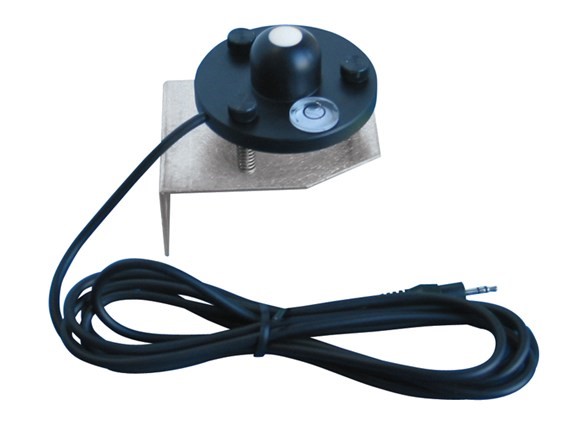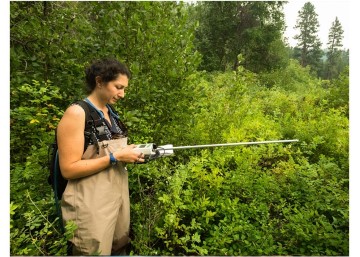LP-80 AccuPAR
leaf area index (LAI) ceptometer
overview
- A leaf area index meter from METER Group (formally Decagon Devices)
- Portable, light-weight, LAI meter
- Easy-to-use with data displayed on screen or in data logger
- Ideal for scientific researchers, growers and consultants
- Measure canopy growth and health
 The AccuPAR LP-80 Ceptometer is a lightweight, portable, linear array of photosynthetically active radiation (PAR) sensors for non-destructive leaf area index (LAI) measurements. It allows you to measure canopy PAR interception and calculate LAI at any location within a plant or forest canopy. PAR data can be used with other climate data to estimate biomass production without destroying the crop. With the AccuPAR there is no need to wait, it uses radiation measurements and other parameters to accurately calculate leaf area index in real time, in the field.
The AccuPAR LP-80 Ceptometer is a lightweight, portable, linear array of photosynthetically active radiation (PAR) sensors for non-destructive leaf area index (LAI) measurements. It allows you to measure canopy PAR interception and calculate LAI at any location within a plant or forest canopy. PAR data can be used with other climate data to estimate biomass production without destroying the crop. With the AccuPAR there is no need to wait, it uses radiation measurements and other parameters to accurately calculate leaf area index in real time, in the field.
lightweight, self-contained
The AccuPAR weighs a little over one pound (0.5kg). The attached controller, powered by four AA batteries, can be used to take measurements manually or log data unattended for short periods of time. It stores over 2,000 readings for later download and analysis.
above canopy sensor
The included external PAR sensor can be used to make simultaneous above, and below-canopy PAR measurements as a reference for intercepted light. Using both the external sensor and the AccuPAR together allows you to get accurate PAR and LAI data in clear, partly cloudy, or overcast sky conditions.
portable, easy-to-use
more information
This section describes the method of manually collecting PAR data for the determination of LAI in a barley and pea canopy.
This example has been included to show how the AccuPAR automatically calculates LAI in the field.
PAR was measured above a barley canopy of 391 umol (umol m-2 s-1) on an overcast day. The average of several measurements below the canopy was 62 umol.
The transmission, tau, is therefore 62/391 = 0.159. Since the day was overcast, fb = 0. If a = 0.9, then A = 0.86. From equation 15 in the AccuPAR manual, LAI = -ln(0.159)/0.86 = 2.14.
If you make a measurement under overcast skies, it was not necessary to have canopy structure information or solar elevation angle. Measurements on overcast days are the simplest for LAI determination and do not require assumptions about canopy structure.
The next example uses measurements on a sunny day. 1614 umol was measured above a pea canopy and 80 umol under the canopy. The fraction of PAR transmitted by the canopy was therefore = 80/1614 = 0.05. The solar zenith angle was 30 degrees, and the beam fraction was 0.881.
The A value for equation 15 (see AccuPAR manual) is again 0.86. Chi for the canopy is unknown, but unless leaves have obvious horizontal or vertical tendencies, a spherical distribution can be assumed and set equal to 1. (The AccuPAR default value for leaf distribution parameter is 1.0, which is applicable for many canopies). For a zenith angle of 30 degrees, this gives K = 0.577.
Substituting these values into equation 14 (see AccuPAR manual) results in LAI = 5.2.
The AccuPAR program utilizes these same equations when the instrument is used to automatically calculate LAI. In the AccuPAR setup menu, you enter your local time, date, and leaf distribution parameter, and it automatically calculates zenith angle and beam fraction. It then couples these parameters with collected intercepted PAR data to determine LAI.
external PAR sensor information
 The AccuPAR is supplied with an external PAR sensor which con nects to the port on the right side of the AccuPAR.
The AccuPAR is supplied with an external PAR sensor which con nects to the port on the right side of the AccuPAR.
The external sensor allows you to take simultaneous above and below canopy PAR readings without having to move the instrument above and below the canopy you are measuring.
For above-canopy PAR data collection, consider connecting the external point sensor to the AccuPAR. This ensures an accurate measurement of intercepted PAR, especially on days where radiation levels vary rapidly. You can mount the sensor on a tripod and level it with a bubble level.
When it is not feasible to use an external point sensor to obtain above-canopy measurements, such as in timber or tropical crops, you have two choices:
1. Use a separate data logger with an attached PAR sensor such as a point quantum sensor, or configure another AccuPAR to log in the unattended mode (one reading per minute, for example) in a clearing outside the canopy. After collecting PAR data within the canopy, you can correlate the data from the two instruments after downloading it from each to a computer.
2. You can use your AccuPAR as an above-canopy reference by regularly collecting above-canopy PAR data in a large clearing within the canopy structure.
example references and scientific publications
Balandier et al. 2009. Improvement of direct tree seeding with cover crops in afforestation: Microclimate and resource availability induced by vegetation composition. Forest Ecology and Management. 257:1716-1724. doi:10.1016/j.foreco.2009.01.032. Weblink.
Ezui et al. 2017. Water and radiation use efficiencies explain the effect of potassium on the productivity of cassava. European Journal of Agronomy, 83, 28-39. Weblink.
Flory & Clay 2009. Invasive plant removal method determines native plant community responses. Journal of Applied Ecology. 46:434-442. doi: 10.1111/j .1365-2664.2009.01610.x. Weblink.
Lamb et al. 2007. Water and nitrogen addition differentially impact plant competition in a native rough fescue grassland. Plant Ecology. 192(1):21-33. Weblink.
Siemann & Rogers. 2007. The role of soil resources in an exotic tree invasion in Texas coastal prairie. Journal of Ecology. 95:689-697. Weblink.
specifications
| feature | specification |
|---|---|
| Data Storage Capacity | 1 MB RAM (over 2,000 measurements) |
| Number of Sensors | 80 |
| PAR Range | 0 to > 2,500 μmol m-2s-1 |
| Resolution | 1 μmol m-2s-1 |
| Probe Length | 84 cm |
| Unattended Logging Interval | User selectable, between 1 and 60 min |
| Instrument Weight | 0.56 kg |
| Data Retrieval | Direct via RS-232/USB |
| Operating Environment | 0-50°C | 0-100% RH |
| External PAR Sensor Cable Length | 5m (longer lengths available upon request) |
| Power | 4 x AAA batteries |
manual & docs
related products





